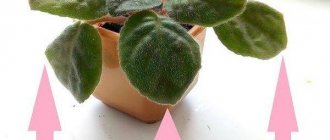What could be easier than growing violet (Saintpaulia)? They live in almost every apartment . But in practice it turns out exactly the opposite. Among collectors, Saintpaulias are considered rather capricious plants.
- Stops blooming;
- Then the leaves stretch out;
- It withers and dies.
Violet leaves droop for various reasons.
Let's look at why this happens in order. We will learn in more detail why the violet dropped its leaves after transplantation and other problems.
Transplanting violets
Preparation
The soil in which it grows is very important for violets. The substrate must be :
Wrong choice of substrate leads to root rotting .
The soil mixture
can be :
- Buy ready-made;
- Take any soil and add sand, vermiculite or perlite;
- Cook it yourself.
Whatever substrate is chosen, it will need to be sifted and baked in the oven for half an hour to destroy:
- Pests;
- And pathogenic bacteria.
Collectors prefer to compose such soil themselves . To do this they take:
- Peat;
- Peat tablets;
- Or coconut substrate in briquettes.
Add 15% sand or perlite, leaf humus or soil from under a birch tree. dry ground horse excrement as a nutrient organic matter , but not much.
The second most important factor in successful planting is the choice of pot . For a small violet, the diameter of the container should be 5-6 cm, for an adult plant - 10-12 cm. But in order not to be mistaken, since violets can be:
Before transplanting the violet, you need to choose a pot.
You should select a pot 1/3 of the diameter of the rosette. It is desirable that the height and width of the container approximately coincide . Ceramic pots are also not recommended, since the clay can cool or heat up greatly depending on the temperature on the windowsill, which has a detrimental effect on the root system of Saintpaulia. If you choose a larger container, the violet will not bloom.
Periodicity
It is recommended to replant violets every 2-3 years. But it is best to do this when the roots completely entangle the earthen ball. This event should be carried out in April - June, in this case the transplant will be more successful :
- There is enough light outside the window;
- On the windowsill at night the temperature does not drop below +18 degrees.
Before transplanting, the plant needs to be watered a little . This is done so that the fragile and sensitive roots of the violet are less injured.
Technology
Carefully remove the violet from the pot and lightly shake off the soil . Remove the lower wilting leaves by sprinkling the removal area with activated carbon. If an adult plant is replanted, then the old pot:
- It is cleared of old soil;
- Scalded with boiling water;
- And fresh drainage and soil are poured there.
In the case when a young Saintpaulia is transplanted, another container of the appropriate size is selected.
Next, the plant is watered so that the soil is distributed evenly , there are no voids and all the roots are in the ground. For prevention, you can pour not plain water, but a solution of Fitosporin and Zircon, 1 ml each. per liter of liquid. The water must be allowed to drain well.
Place a plastic bag or a cut plastic bottle on the flower There is no need to place Saintpaulia on a windowsill, as cold air or drafts can damage the plant. The temperature day and night should be 20-24 degrees. It is best to place the violet on a shelf under fluorescent lamps.
But many beginners ask the question: why doesn’t violet grow after transplantation? Let's find out in more detail why this happens.
Possible problems
I wonder what to do if the violet withers? Not only beginners, but also experienced collectors are faced with the fact that after transplanting violets lose their turgor very much, begin to die and have to be re-rooted.
The violet may not survive the transplant.
There can be many reasons why violet leaves drooped after transplantation, but there are three main ones :
- Lack of light;
- Overwatering;
- Low temperature.
drooping leaves
In what case do Saintpaulia leaves lose turgor? When the roots don't work. This can happen if :
- The plant was dried;
- The flower was watered too often and abundantly, the roots rotted.
In the first case, you can try to revive the violet:
- Take a container of larger diameter;
- Pour water with zircon and phytosporin;
- Immerse the pot with the plant there for an hour;
- Let the water drain;
- Place a plastic bag on the violet;
- And put it in a dark place for several days. The temperature there should be 22-24 degrees.
If this does not help, then Saintpaulia, as in the second case, will have to be re-rooted . The roots are removed, the trunk is cleaned and either placed in a container of water in which an activated carbon tablet is dissolved. Or they are immediately placed in damp peat under a bag.
How to fix the problem?
It is known that many problems in the growth of violets arise due to the illumination of the place where they are located. You can correct the problem by urgently moving the pot with Saintpaulia to a place where there is enough light, but without direct sunlight. It is better to place containers with flowers on south-eastern or south-western window sills. It is important that violets with light leaves need less light than those with dark leaves. Violets with thin light green leaves are best moved to the background from the window. Specimens with dense dark green leaves require light shading.
When the light falls on a flower from one side, it is advisable to turn the violet more often, first with one side towards the light, then with the other.
In winter, it is better to place containers of water next to the violets, then the air humidity will increase. The Saintpaulias need this vitally. The second way to reduce dryness in a room is to water through a tray. Wet pebbles or moss placed on a pallet will also save the situation.
It is necessary to apply fertilizers to the soil when the flower has slowed down in development and the leaves have risen up and curled. If at this moment the Saintpaulia has faded, then the application of nitrogenous fertilizers will help return the leaf rosette to its normal position. But during the flowering period, too much nitrogen will lead to an increase in green mass and a lack of flowering of the ornamental crop.
When changing the position of the violet, you should not rely on the old leaves returning to normal. No, only young leaves will acquire a normal horizontal position when the old ones die.
Aftercare
The violet is such a fragile, delicate and capricious plant that the main method of eliminating errors in care is to replant the flower. To minimize the resuscitation period, you must strictly follow simple rules :
- Quite bright, but diffused light;
- Lighting duration is 10-12 hours a day;
- The temperature is 18-24 degrees without sudden changes and drafts;
- Proper watering, that is, regularly and moderately. The soil should always be moist, but not wet.
A few more useful tips, following which you will need to replant Saintpaulia no more than once every 2-3 years :
- To make the rosette beautiful, after each watering, turn the flower 45 degrees relative to the light source;
After transplantation, the violet requires good care.
With these simple manipulations, the violet will be healthy and beautiful for a long time .
Why do violets' leaves droop?
Improper watering leads to problems with roots. If the soil is too dry, thin roots die , which leads to the fact that the root system cannot absorb water. Otherwise, if the earthen ball is over-moistened, the roots may begin to rot . In both cases, the leaves droop and lose turgor.
A pot that is too small or too large will also cause drooping leaves:
- When growing Saintpaulia in a pot that is too small, timely watering is very important, the plant dries out very quickly , and the process of roots dying begins;
- otherwise, if there is a large container, the roots cannot cope with the volume of water. The soil remains wet for a long time, the roots cease to function fully. And as a result, the leaves of the plant drop.
For violets, the size of the pot is very important.
Hypothermia and very high temperatures have a detrimental effect on Saintpaulia:
- hypothermia most often occurs in the fall when the house has become cold and the batteries have not yet been turned on, or in the spring in a similar situation when the batteries have already been turned off. Also, a sharp drop in temperature occurs during ventilation. In this situation, the root system suffers;
- overheating most often occurs on the windowsill, the sun's rays penetrating through the glass intensely heat the violet, it begins to rapidly lose moisture, the leaves become sluggish, lose turgor, and droop. The more humid the room, the easier the violets tolerate overheating.
The recommended maintenance temperature for Saintpaulia is 20-22 degrees ; at night the temperature should not drop sharply, by no more than three degrees.
In the case when the lower tier of leaves begins to fall, a possible reason may be the venerable age of the violet . In such a situation, if nothing is done, the lower leaves will gradually die off. The violet will look like a “palm” on a curved stem. The root system will not cope with its functions and the leaves will shred and wither.
Drooping leaves may also indicate that the pot contains heavy, compacted soil. This situation occurs most often among beginners when purchasing purchased soil and using it without raising agents.
Such soil becomes dense over time; when watering, water sits on the surface for minutes without being absorbed. In such soil, the roots of violets cannot breathe and develop.
Wrong choice of soil
When inspecting the soil, you need to pick up the pot and estimate its weight. If the soil itself is light, the soil is dry, light to the touch and lags behind the walls, then this is a case when the soil is overdried. If the pot is heavy and wet to the touch, you need to remove the earthen lump from the pot and inspect it.
Signs of rotting of the root system are the appearance of a smell of rot and mold , dark brown or black color of easily detachable roots. Healthy roots are white or light brown in color, quite strong and elastic. If the soil looks like one lump, the finger enters it with difficulty, the water does not absorb for a long time - this is a case of heavy, compacted soil.
When inspecting the rosette, you need to compare its diameter with the size of the pot. The rosette should be three times the size of the pot . If the pot is different in size, then it is small or too large for the plant.
Reasons why violets may dry out
The difficulty is that it can be difficult to immediately decide what the problem is. Violet, in general, is very capricious and can express any discomfort through an unhealthy appearance.
And yet there are the most likely reasons why the leaves of the plant begin to dry out.
Too much sun
Saintpaulia is a heat-loving plant, its homeland is Africa. But the flower does not tolerate direct sunlight. In its homeland, violet grows in the thick of the jungle and on the slopes of mountains, but not on the southern side, but where direct exposure to the sun is not so long.
If your pot is on a south-facing windowsill and the sun shines into the room most of the day, the violet may not like it. Its delicate leaves simply burn under the rays. They quickly begin to turn yellow and dry out.
To save Saintpaulia, move the pot to a place where there is a lot of light, but there is no direct sunlight.
Overfilling or underfilling
If the leaves of a violet turn black, this indicates excessive watering. Darkening usually starts at the ends. Gradually the entire leaf begins to wither and falls off. When there is too much water and the soil does not have time to dry out, the violet roots begin to rot.
If you notice blackening, you should definitely check the roots. Carefully dig the plant out of the soil. If rotten roots are detected, you need to remove all spoiled remains and replant the plant in a fresh substrate.
With a lack of moisture, the leaves turn brown, turn yellow, become dry, and shrink. Actually, any plant will begin to dry out when it is not watered for a long time.
The peculiarity of violets is that they instantly react to any factor that causes them inconvenience.
In this case, it is enough to normalize the watering of the Saintpaulias and they will return to normal.
Pests
Drying of the leaves can be caused by mites. They often nest on the underside of leaves, and their sizes are so small that they are almost invisible to the eye. The leaves begin to become covered with yellow-brown spots on top and gradually dry out.
The best varieties of violets, their features
The selection of violets has produced different types of indoor culture. Industrial production of the plant involves its use in perfumery and cosmetology. Plantations cultivate crops that can decorate official receptions, indoor and outdoor celebrations.
Collectible types of Saintpaulias are characterized by the volume of inflorescences and the sophistication of the color palette. And the leaves of violets in this series come in both light green and different emerald shades. The variegated variety of violet has wide leaves and represents the entire palette of green in color.
The best varieties of violets are considered:
- The bride's bouquet. Snow-white double flowers are united in inflorescences and form a basket of delicate petals. And velvety dark green leaves highlight the tenderness of Saintpaulia.
- The pink violet Liens Pirates Treasure has a crimson edging along the edges of its petals. Against this background, small purple dots are visible. Below are leaves, dark green, with dark veins painted on them.
- Winter rose. Deep blue wavy flower petals are decorated with a white border. The composition is completed by medium-sized leaves with a pubescent surface.
- A gift for a loved one. One of the types of blue Saintpaulia, on top of which there is a bouquet of double inflorescences, and at the bottom they are supported by leaves with a cream edging.
- Magdalene. The inflorescences of the variety with delicate pink petals are located close to each other. Violet leaves are ordinary round and light green in color.
- Elise Blizzard Baths. In addition to the delicate white flowers, the foliage adds sophistication to the plant. Heart-shaped leaves highlight the beauty of the violet.
Magenta. The complex petals are burgundy inside, and the wavy edges are smoky white. Hidden inside is a yellow center.
Not only lush or modest small inflorescences adorn Saintpaulia. Without the leaves that form a rosette at the bottom of the plant, the violet would lose its elegance and uniqueness.
General advice on what to do if a violet withers and dries
- Remove damaged leaves immediately; they will not recover anyway, and the plant will have to spend a lot of energy maintaining their vital activity.
- If you find signs of disease, remove the violet away from other flowers, as there may be pests on it and your neighbors risk infecting them too.
- Regardless of the cause of the disease, it is better to transplant the flower into a new substrate.
- Violets are very sensitive to microclimate; it must be stable. Avoid room temperature changes, drafts, and stuffiness.
- Water only with purified warm water.
- Bathe your violets from time to time, this will support their immunity.
- In winter, heat-loving plants are especially vulnerable; monitor them carefully.
Even a very experienced florist will not be able to immediately tell you why the violet is drying up. You will have to carefully review every possible cause and change the conditions of care.
It is not always possible to save the plant. But even if things are bad, you can try to revive the cutting by cutting it at the root, removing most of the leaves and placing it in water so that it takes on new roots. Very often in such cases the violet begins a second life.
The main causes of leaf curling
So, why do violet leaves curl? The most likely causes of this phenomenon are listed below:
- Bay
- Pests
- Lighting violation
- Incorrect transplant
- Excess fertilizer
The most common reason. Beginning flower growers often mistake flooding for a lack of watering. Their symptoms are very similar: wilting and curling of leaf edges, loss of turgor. If these symptoms are not responded to properly, the plant will soon die.
Pests can also cause violet leaves to curl, most often the cyclamen mite. Signs of tick infestation are as follows:
- Curled edges of leaf plates
- Twisted stems
- Excessive pubescence of leaves and petioles. From a distance you might even think that the plant is covered with a thick layer of dust
- Withering and falling of flower stalks
- Deformed growth point
- Developmental delay
Cyclamen mite colonies usually settle on the lower part of leaf blades. There they feed on the sap of the plant and reproduce. Due to its very small size, it is very difficult to see the pest, which significantly complicates the fight against it in the early stages.
Errors in lighting mode
Insufficient or excessive lighting can also cause this physiological disorder. This happens especially often when violets are kept under lamps. In this case, the daylight hours are too long for them, and the light intensity is too high.
The cause of deformation of sheet plates can also be too high an ambient temperature. In this case, the violet tries to reduce moisture consumption and curls the leaves.
Add a comment Cancel reply
You must be logged in to post a comment.
Found a mistake? Report it: 1) Select the error with the mouse 2) Press CTRL+Enter. Read more.
After replanting, the lower leaves began to wither, laying on the edge of the pot, rotting either from the stem or from the end of the leaf.
I transplanted it just a few days ago and not only this violet, but several, all the others don’t have this. This didn't happen before.
I have already cut off several leaves, please tell me what it could be. I'm very sorry for the plant.
The photo quality is not very good, but you can still see that this is not normal.
- Login or register to post comments
- print version











